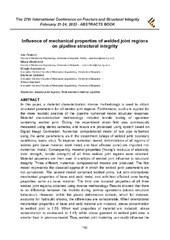Приказ основних података о документу
Influence of mechanical properties of welded joint regions on pipeline structural integrity
| dc.creator | Petrović, Ana | |
| dc.creator | Momčilović, Nikola | |
| dc.creator | Aranđelović, Mihajlo | |
| dc.creator | Đorđević, Branislav | |
| dc.creator | Sedmak, Simon | |
| dc.date.accessioned | 2023-03-13T20:09:08Z | |
| dc.date.available | 2023-03-13T20:09:08Z | |
| dc.date.issued | 2023 | |
| dc.identifier.uri | https://machinery.mas.bg.ac.rs/handle/123456789/6026 | |
| dc.description.abstract | In this paper, a material characterization inverse methodology is used to obtain structural parameters for all welded joint regions. Furthermore, such are applied for the more realistic analysis of the pipeline numerical model structural response. Material characterization methodology included tensile testing of specimen containing welded joint. During the experiment strain field was continuously measured using stereo cameras, and results are processed using system based on Digital Image Correlation. Numerical computational model of test pipe is formed using the same parameters, as in the experiment (shape of welded joint, boundary conditions, loads, etc.). To improve numerical model, deformations of all regions of welded joint (base material, weld metal, and heat affected zone) are imported into numerical model. Consequently, material properties (Young’s modulus of elasticity, yield strength, tensile strength) of all three welded joint regions were obtained. Material properties are then used in analysis of welded joint influence to structural integrity. Three different numerical computational models are produced. The first model represents the classical approach in which the welded joint parameters are not considered. The second model contained welded joints, but with orientational mechanical properties of base and weld metal, and with heat affected zone having properties same as base material. The third one included properties of all three welded joint regions, obtained using inverse methodology. Results showed that there is no difference between the models during service operations (elastic structural behaviour). However, within the plastic deformation domain, which for instance, accounts for hydraulic shocks, the differences are considerable. When orientational mechanical properties of base and weld material are included, stress concentration in welded joint is 1.59. When real properties of material are included, stress concentration is decreased to 1.49, while stress gradient in welded joint area is smaller than in previous model. Thus, welded joint modelling can vastly influence the plastic domain structural behaviour of the pipeline structure. | sr |
| dc.language.iso | en | sr |
| dc.relation | info:eu-repo/grantAgreement/MESTD/inst-2020/200105/RS// | sr |
| dc.rights | openAccess | sr |
| dc.rights.uri | https://creativecommons.org/licenses/by/4.0/ | |
| dc.source | The 27th International Conference on Fracture and Structural Integrity | sr |
| dc.subject | welded joint regions | sr |
| dc.subject | inite element method | sr |
| dc.subject | pipeline | sr |
| dc.title | Influence of mechanical properties of welded joint regions on pipeline structural integrity | sr |
| dc.type | conferenceObject | sr |
| dc.rights.license | BY | sr |
| dc.citation.epage | 183 | |
| dc.citation.rank | M34 | |
| dc.citation.spage | 182 | |
| dc.identifier.fulltext | http://machinery.mas.bg.ac.rs/bitstream/id/14895/bitstream_14895.pdf | |
| dc.identifier.rcub | https://hdl.handle.net/21.15107/rcub_machinery_6026 | |
| dc.type.version | publishedVersion | sr |


